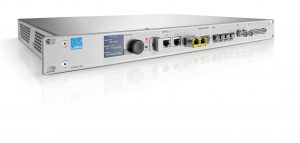NAB 2019: Lawo Makes Strides Towards AES67/ST2110 Audio Gateway Improvement
Power Core, Lawo’s (Booth N2503) versatile AoIP mixing engine and I/O node, has become even more powerful — thanks to new features and capabilities debuting at NAB 2019. Initially introduced as a DSP mixing engine and modular I/O system for Ruby radio consoles, many broadcasters are using Power Core as a gateway between legacy audio formats and standards-based IP media networks.
 The ST2110-30 standard ensures seamless interoperability of audio and video equipment in combined radio / TV broadcast plants.
The ST2110-30 standard ensures seamless interoperability of audio and video equipment in combined radio / TV broadcast plants.
Power Core features new at NAB 2019 include:
- A Dante® card with dual-redundant ports and sample rate conversion, allowing easy integration of pro-audio equipment into broadcast environments.
- Dual-redundant front-panel SFP ports for AoIP. Now, broadcasters have their choice of optical or copper network connections, sans the cost of external media converters.
- ST2022-7 Seamless Protection Switching, which provides dual-redundant AoIP network connections. Twin active links guard against audio loss should one link be interrupted.
“Power Core packs a staggering amount of DSP and modular I/O into only 1RU,” says Lawo Radio Marketing Specialist Clark Novak. “On the front panel alone, there are 128 dual-redundant AES67 streams and 128 dual-redundant MADI channels. Then there are 8 rear-panel expansion slots. Combine this with 96 DSP channels and nearly 2,000 routing crosspoints, and it’s no wonder radio and TV stations are finding that Power Core increases capabilities, simplifies infrastructure and reduces costs. It’s a win-win!”
“The broadcasting industry’s migration to IP has triggered a convergence of radio and TV technologies,” notes Novak. “That’s why Power Core is quickly becoming the preferred media-aggregation tool for TV broadcasters, especially those fielding OB units. “The ability to connect and convert between AES3, AES67, MADI, Dante and ST2110-30 makes Power Core a
bonafide ‘Über-Node.’”
Clients can add more capacity with eight rear-panel card slots, which allow a la carte addition of analog, AES3, MADI and Dante interfaces, and a unique Studio I/O card that provides mic inputs and headphone and monitor outputs.
